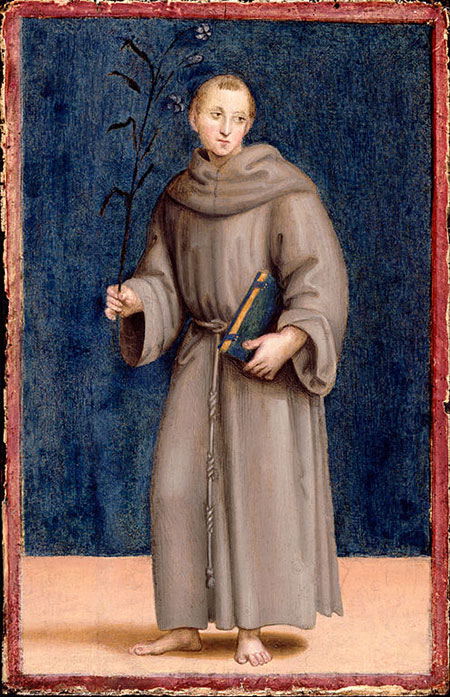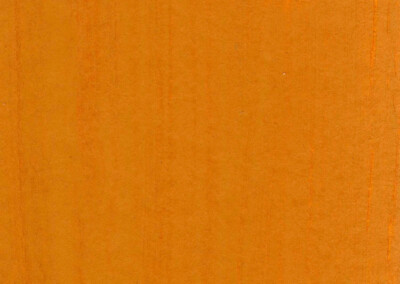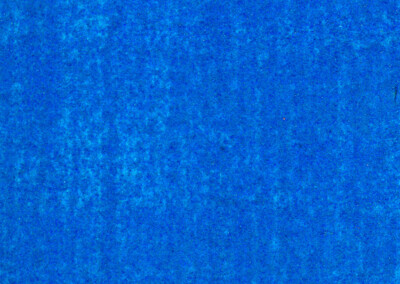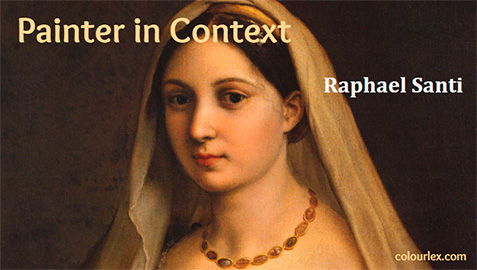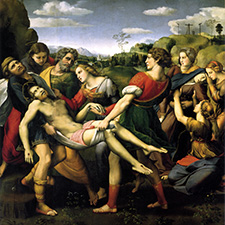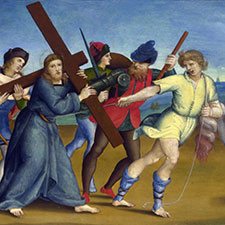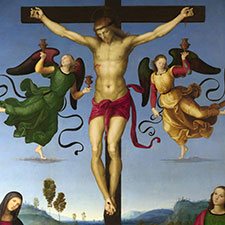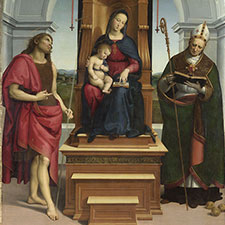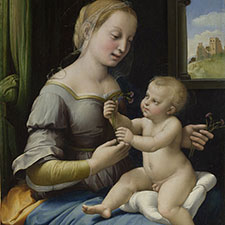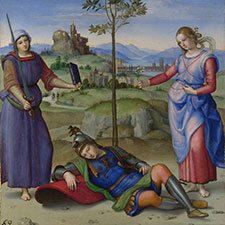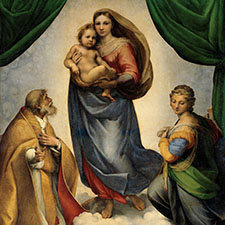Raphael, The Procession to Calvary
1504-05Paintings sorted by Historical period | Painter | Subject matter | Pigments used
History of the Painting
The painting was originally a part of the central panel of the predella (lower part of the platform on which an altar is placed) below an altarpiece of the Virgin and Child with Saints, known today as the ‘Colonna Altarpiece’. It was made for the Church of Santa Antonio, Perugia.
The Colonna Altarpiece is presently owned by the Metropolitan Museum of Art in New York (2). One other part of the predella Lamentation over the Dead Christ is part of the collection of the Isabella Stewart Gardner Museum in Boston, the other part Saint Anthony of Padua is in the Dulwich Picture Gallery in London.
See two of these paintings in the section “Related Paintings” below.
References
(1) Roy, A., Spring, M., Plazzotta, C. ‘Raphael’s Early Work in the National Gallery: Paintings before Rome‘. National Gallery Technical Bulletin Vol 25, pp 4–35. Available as pdf.
(2) Oberhuber, Konrad, The Colonna Altarpiece in the Metropolitan Museum and Problems of the Early Style of Raphael: Metropolitan Museum Journal, v. 12 (1977). Available as pdf.
Related Paintings: Other Parts of the Altar
The painting The Procession to Calvary was originally a part of the central panel of the predella (lower part or the plattform on which an altar is placed) below an altarpiece of the Virgin and Child with Saints, known today as the ‘Colonna Altarpiece‘. It was made for the Church of Santa Antonio, Perugia.
The Colonna Altarpiece is presently owned by the Metropolitan Museum of Art in New York (1,2).
Raphael, Madonna and Child Enthroned with Saints (Colonna Altarpiece),
ca 1504 Metropolitan Museum of Art
One part of the predella Saint Anthony of Padua is owned by the Dulwich Picture Gallery in London.
Raphael, Saint Anthony of Padua, ca 1504
Dulwich Picture Gallery
The other part of the predella Lamentation over the Dead Christ is in the collection of the Isabella Stewart Gardner Museum in Boston.
References
(1) Oberhuber, Konrad, The Colonna Altarpiece in the Metropolitan Museum and Problems of the Early Style of Raphael: Metropolitan Museum Journal, v. 12 (1977). Available as pdf.
(2) Linda Wolk-Simon. Raphael at the Metropolitan: The Colonna Altarpiece. Exh. cat. in The Metropolitan Museum of Art Bulletin (Spring 2006), pp. 11, 65, cat. 1E, fig. 8, 11, 32.
Overview
Medium: Oil
Support: Poplar
Size: 24.4 x 85.5 cm
Art period: High Renaissance
National Gallery London
NG2919
Pigments
Pigment Analysis
This pigment analysis is based on the work of the scientists at the National Gallery London (1). The results of the investigation have been published in references (1) and (2) and all the microscopic images of cross-sections, the infrared and x-ray images are included in the website of the Raphael Research Project of the National Gallery London (3).

1 Blue sky: natural ultramarine mixed with white over a layer of azurite also mixed with white.
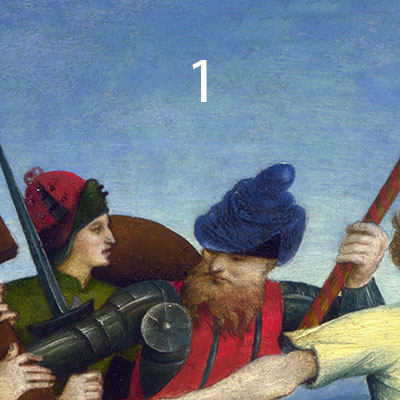
2 Christ’s blue robe: azurite with small amounts of red lake darkened with age.
3 Blue robe of the figure behind Christ: natural ultramarine.
4 Christ’s halo: either mordant gilding or finely powdered metallic gold (shell gold).
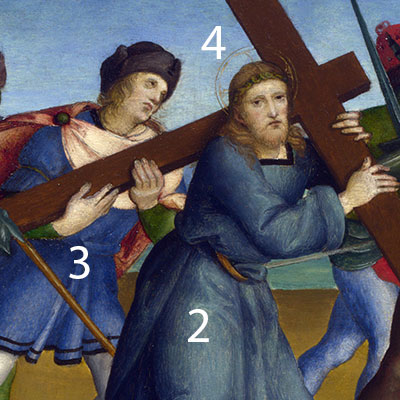
5 Saint John’s red drapery: the underpaint of lead white, powdered glass and brazilwood lake which changed its colour with age from red to yellow. On top is a thin layer of vermilion and faded red lake. The hose of the figure to the right is painted in red lake as well.
6 Virgin’s purplish and aubergine cloak: underpaint of azurite and white covered with a mixture of black, lead white, a small amount of vermilion, and pale brownish-red lake.
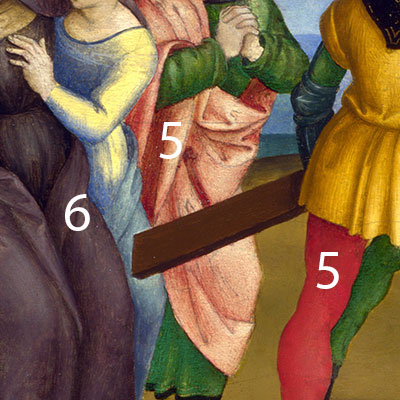
7 Simon of Cyrene’s greyish-brown hose: finely powdered metallic bismuth.
8 Yellow tunic of the soldier dragging Christ: lead-tin yellow mixed with lead white.
9 Yellow foreground: strongly coloured yellow ochre with some azurite and lead-tin yellow.
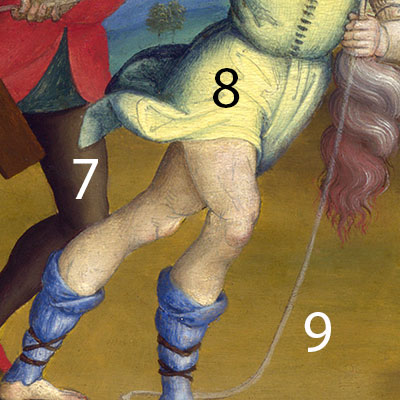
10 Yellow robe of the horseman: lead-tin yellow mixed with strongly coloured yellow ochre.
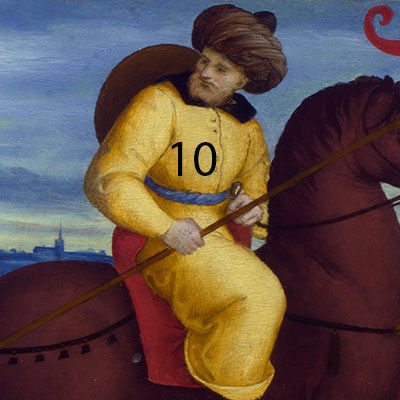
References
(1) Roy, A., Spring, M., Plazzotta, C. ‘Raphael’s Early Work in the National Gallery: Paintings before Rome‘. National Gallery Technical Bulletin Vol 25, pp 4–35. Available as pdf.
(2) Marika Spring, Raphael’s Materials: Some New Discoveries and their Context within Early Sixteenth-Century Painting, Eu-ARTECH Raphael Workshop, National Gallery London, 2004. Available as pdf.
(3) The Procession to Calvary, Raphael, Raphael Research Resource, National Gallery London.
Pigments Used in This Painting
Resources
See the collection of online and offline resources such as books, articles, videos, and websites on Raphael in the section ‘Resources on Painters‘
PowerPoint Presentations
Painter in Context: Raphael
A richly illustrated presentation on the Italian Renaissance painter Raphael Santi containing information on painting technique, pigments employed, and important written and online resources.
Number of slides: 16
Formats included in the download: PowerPoint Screen Presentation (ppsx) and pdf
Publications and Websites
Publications
(1) Roy, A., Spring, M., Plazzotta, C. ‘Raphael’s Early Work in the National Gallery: Paintings before Rome‘. National Gallery Technical Bulletin Vol 25, pp 4–35. Available as pdf.
(2) Marika Spring, Raphael’s Materials: Some New Discoveries and their Context within Early Sixteenth-Century Painting, Eu-ARTECH Raphael Workshop, National Gallery London, 2004. Available as pdf.
(3) Linda Wolk-Simon. Raphael at the Metropolitan: The Colonna Altarpiece. Exh. cat. in The Metropolitan Museum of Art Bulletin (Spring 2006), pp. 11, 65, cat. 1E, fig. 8, 11, 32.
(4) Hugo Chapman, Tom Henry and Carol Plazzotta, Raphael – from Urbino to Rome, exhibition catalog, National Gallery London, 2004. Available as pdf.
(5) Oberhuber, Konrad, The Colonna Altarpiece in the Metropolitan Museum and Problems of the Early Style of Raphael: Metropolitan Museum Journal, v. 12 (1977). Available as pdf.
Websites
Studying Raphael, Raphael Research Resource, National Gallery London.



